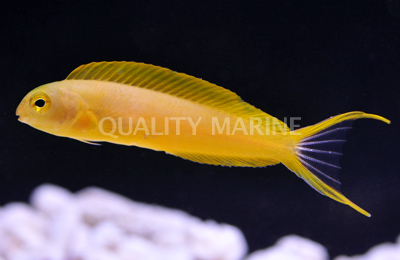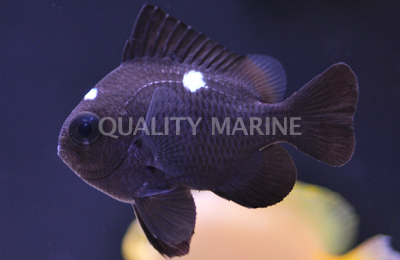Fabulous Fijian Fishes

The islands of Fiji are an idyll of tropical paradise, with a unique marine fauna that is in many cases found nowhere else. There are more than eight-hundred volcanic islands and islets that make up the country, and these sit at an important confluence of geography and hydrology in the region. To understand why the fishes here are so different, we need to take a quick moment to look at how the waters in this corner of the globe are moving about.
The South Pacific Gyre is an enormous counterclockwise movement that takes the cold, nutrient-rich waters of the Southern Ocean upwards along the Chilean coastline of South America and then westward towards Australia. This western leg of the journey is referred to as the South Equatorial Current, and it is a major factor in determining where the fishes of Fiji come from. As this stream of oceanic water passes north of Fiji, it creates an easterly countercurrent just to its south that draws the surface waters of Vanuatu towards Fiji. And, since the marinelife of Vanuatu is in close contact with the rest of the West Pacific, so to are the eastern portions of MelanesiaFiji, Tonga, and Samoa.
To the east of Fiji sits Tonga, an island nation formed from the subduction of the Pacific Plate beneath the Australian Plate. This has created the Tonga Trench, a deep barrier of open water that shallow-water fishes are unable to traverse, thus isolating the region from the islands of Polynesia to the east. And so, in this way, Fiji, Tonga, and Samoa have emerged as a hotbed of speciation during the past few million years.
The most interesting thing about these islands is that, while they often have their own unique species, these seem to invariably belong to more widespread complexes distributed either across the West Pacific or the South Pacific. So youll never find something truly novel to this region. As well soon see, the fishes of Fiji always have a close relative somewhere else, usually in Australia, illustrating how the reefs in this area are closely interconnected by the surface currents flowing through these islands.

Barbers Tomato Clownfish (Amphiprion barberi)
This colorful clownfish is a perfect example of what weve just discussed. It belongs to the Tomato Clownfish species group, which is easily recognized for having just a single stripe as an adult (though this is missing in a couple populations) and also for their close association with the Bubbletip Anemone. The group as a whole ranges from the Andaman Sea to the Ryukyu Islands south of Japan, into Micronesia and south to Fiji, Tonga, and Samoa. You wont ever find these in Polynesia, though, as their host anemone doesnt occur there.
For many years, the vibrantly red tomato clownfish from Fiji was confused with a similarly colored species found along the northwestern coast of Australia, Amphiprion rubrocinctus, which created all sorts of confusion among aquarists. It was only in 2008 that genetic data helped clear this up, resulting in the description of this Fijian fish as a newly recognized species.
But theres still more work to do in this genus! We have good reason to believe that several additional clownfishes found here are similarly distinct and will no doubt be reclassified as new species once they are properly studied. For example, the variant of the Orangefin Clownfish in Fiji has all of its fins orange, while the true Amphiprion chrysopterus, found across Micronesia, has a white caudal fin. The Pink Skunk Clownfish is another fine example, as the population in Fiji is actually bright orange!

Nahackys Fairy Wrasse (Cirrhilabrus nahackyi)
Fairy wrasses are especially prone to diversifying whenever their populations become isolated. This is due to the strong influence sexual selection has within the group, causing beautiful new color patterns to pop up in the blink of an eye, relatively speaking. The Hooded Fairy Wrasse species group is especially germane to this discussion, as the entire assemblage is restricted to the Southwest Pacific. The most familiar member is the Coral Seas C. bathyphilus, and the true Hooded Fairy Wrasse, the recently described C. efatensis, occurs only in Vanuatu.
Meanwhile, just to the east in Fiji and Tonga occurs a close relative that shares a similar appearance, but with some clear and obvious differences in its fin shape and color palette. Nahackys Fairy Wrasse is one of the most infrequently seen Cirrhilabrus within the aquarium trade, owing to the limited amount of collection done in the deeper waters of these countries. Its most outstanding feature is the peculiar elongation of the first dorsal spine, giving it the appearance of a cockatoos crest.
And this isnt the only fairy wrasse unique to these waters, as many others are still awaiting study. The local variant of C. punctatus is clearly different from those found in Vanuatu (which have an orange line) and the Coral Sea (which are duller in color). The same is presumably true for the challenging complex surrounding C. exquisitus, and this might also apply to C. scottorum.

Canary Fangblenny (Meiacanthus oualanensis)
This cheery yellow fish is probably the most popular species from the diverse fangblenny genus found in the aquarium trade. It belongs to a highly speciose complex scattered all across the Indo-West Pacific, but its only in Fiji that this group turned yellow. Who knows why they did, but it worked out well for aquarists.
Whats especially interesting about this species is how different it is from neighboring populations in Tonga and Samoa. Those from the former are likewise recognized as a distinct species, M. tongaensis, and differ in having a slightly greener tone to their forebody and a black stripe present in the dorsal fin. Meanwhile, those from nearby Samoa are in many ways more similar to the traditional bicolored look of M. atrodorsalis (and, quite likely, represents another undescribed species itself). For fish with limited larval dispersal, which applies to both the Meiacanthus fangblennies and the Amphiprion clownfishes, it becomes all too easy for reproductively isolated populations to form in this region.

Fijian Domino Damselfish (Dascyllus cf trimaculatus)
In 2001, the legendary ichthyologist Jack Randall described a colorful new domino damselfish from the remote reefs of the Line and Phoenix islands. Unlike the traditional black and white look of the true Domino Damselfish (Dascyllus trimaculatus), this new fish, D. auripinnis, was bright yellow along its bottom half, and has been referred to commonly as the Golden Domino Damselfish. Specimens of this fish do occasionally find themselves exported from Kiritimati, but, in general, it is an uncommon offering. More commonly seen is a population from Fiji that is in many ways similar, but still clearly different.
In Fiji, as well as Tonga and Samoa, the local domino damselfishes are mostly black, but with a noticeable smattering of gold brightening their lower portions. The fins arent quite as bright and purely yellow as the true D. auripinnis, but, at the same time, they arent solidly black like in D. trimaculatus. We can look at other nearby populations in this group to confirm this fishs uniqueness, as those in Vanuatu and the Coral Sea to the west have the traditional dark fins of the Domino Damselfish, while the same is true for those in the islands of Polynesia to the east.
We can look at this geographic breakdown and easily deduce that the golden variant from Fiji is too isolated to be the true D. auripinnis and too different from neighboring populations to be D. trimaculatus. And, as it turns out, genetic data supports these differences as well. In fact, neither of the black Domino Damselfishes in the Pacific Ocean are the true D. trimaculatus, as that fish is now thought to be found only in the Indian Ocean, having been originally described from the Red Sea.
A Fijian Biotope
This is just a small selection of Fijis unique marinelife. Others include the Blue Velvet Angelfish (Centropyge deborae) and, possibly, Woodheads Angelfish (C. woodheadi), though the validity of that last one is still up in the air. Theres a bicolored Foxface found here, Siganus uspi, and, as with the fangblennies and clownfishes, it has a sister species in Tonga, the all-black S. niger. Endemism is even more pronounced among the gobies and blennies and triplefins, small fish that tend to breed benthically, but few of these ever make it into the aquarium trade.
A Fijian biotope comprised only of the regions endemic fishes would be an interesting concept, but it comes with some limitations. Fish groups that have longer pelagic larval stages typically dont have any endemic representatives in Fiji. This rules out most surgeonfishes, triggerfishes, angelfishes, pufferfishes and groupers/basslets. But the list shown here should get you off to a good start.